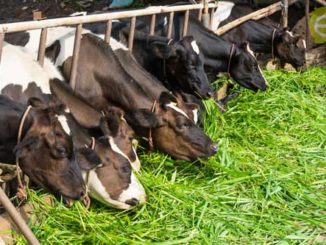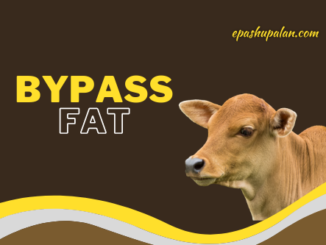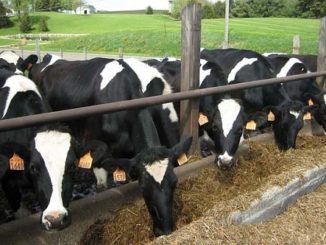INTRODUCTION
Phytobiotics are the plant derived products added to the feed in order to improve performance of agricultural livestock. This addresses mainly the purpose of use in terms of a feed additive to healthy animals under common practical conditions of production of food of animal origin rather than the veterinary use for prophylaxis and therapy of diagnosed health problems. Phytobiotics comprise of very wide range of substances with respect to biological origin, formulation, chemical description and purity. The active compounds of phytobiotics are secondary plant constituents. Their primary mode of action is often not known sufficiently to explain the final effects in vivo. Phytobiotics usually contain mixtures of compounds with beneficial and potentially adverse effects, depending on the nature and the dose of the respective substances. Nevertheless, common knowledge from folk medicine and recent experiences from feeding studies give significant rise to accept the principal potential of phytobiotics to improve zootechnical performance in agricultural livestock significantly. In addition to feed additive products, phytobiotics also provide consultative services focused on intestinal health, stress reduction, and increased nutrient bioavailability for a wide array of animal species. Phytobiotics supply the bioenergy industry with technology and fermentation stimulants at both the farm and industry level.
CLASSIFICATION OF PHYTOBIOTICS
Within this variety, some subgroups may be classified as herbs (product from flowering, non-woody and non persistent plants), botanicals (entire or processed parts of a plant, e.g. root, leaves, bark), essential oils (hydro distilled extracts of volatile plant compounds) and oleoresins (extracts based on non-aqueous solvents). Herbs, spices, essential oils, leoresins, carbohydrates (Heteroglycans), prebiotic oligosaccharides and arabinogalactans/ fucogalactoxyglucans (Acacia tree) are some varieties. Phytobiotics, especially those from the group of essential oils are often claimed to improve flavour and palatability of feed and hence to raise performance of agricultural livestock through stimulation of feed intake. There are numerous reports on positive effects, but also on depression of feed intake especially at rising dietary additions of these substances.
Besides the problem to identify the optimum dietary concentration within the vast variety of potentially active substances, the varying contents of concomitant compounds with potentially adverse impact on palatability may additionally modify the total effect on feed intake. The latter seems to be the case especially when using intact parts of herbs compared to plant extracts providing a more standardized composition. In total, the mode of action to stimulate feed intake remains unclear, since in contrast to sweeteners, while the rising addition of phytobiotics often reduce palatability. In some cases it may be hypothesized that higher feed intake might result indirectly of from a higher saliva production rather than a better taste of feed. Some phytobiotics act also as antioxidant (e.g. rosemary oil) and may thus indirectly stabilize the nutritional and sensorial feed quality. This effect could be of relevance to feed rich in fat (oil), like for pet feed. But it remains unclear whether dietary additions necessary to induce protective effects comparable to common antioxidants (e.g. tocopherols, BHA, BHT) are compatible with sufficient palatability of the feed.
FAVOURABLE EFFECTS OF PHYTOBIOTICS ON HEALTH AND PRODUCTION
Phytobiotics act as anti-oxidants, anti-bacterials, anti-inflammatory, appetite and digestion stimulants, carminatives, galactogogues and colourants. Phytobiotics stimulate endocrine system. They facilitate nutrient metabolism and enhance palatability. They are the potent natural feed additives.
Effects of phytobiotics on specific physiological functions
High basal metabolic rate produces large amount of free radicals causing oxidative stress. Plant extracts in polyphenols are effective to prevent lipid oxidation in food products and reduce meat hardness by 35.9 %. Plant alkaloids reduce feed conversion ratio at different parts per million. Gastric emptying slows down. Saponins reduce intestinal ammonia formation resulting aerial pollution of housing environment and health stress.
Stimulation of digestive secretions
Stimulation of digestive secretions such as saliva, digestive enzymes, bile, and mucus is often considered to be a core mode of action of phytobiotics. In context with highly productive agricultural livestock it has to be mentioned that stimulation of digestive secretion is not a beneficial action per se. It is often a concomitant phenomenon of an irritating action being accompanied by shortening of intestinal villi length (resulting from higher tissue turnover) and a higher passage rate of digesta. Nevertheless, such effects may have a beneficial action at low hygiene as they counteract the attack of potential pathogens to the intestinal tissue.
Antimicrobial action
There is a vast variety of in vitro studies on antimicrobial actions of phytobiotics while until now there is only little experimental experience when using such products as feed additives to healthy animals under common practical conditions. Nevertheless the antimicrobial property may be considered as mode of action being most relevant to agricultural livestock, especially to young animals e.g. antibiotic feed additives and organic acids. Phytobiotics are considered as potential candidates contributing to stabilize eubiosis of intestinal microbiota. The overall benefit to animals supplied with such types of feed additives originates from the complex interaction between the direct antimicrobial action in the gastrointestinal tract, the resulting relief of the host animal from microbial degradation of nutrients prior to absorption and exposure to undesired microbial products (e.g. toxins) and the reaction of the organism on higher influx of nutrients from the intestinal tract and lower immune defence stress.
Feed additives decrease microbial activity at the end of the ileum, caecum and colon. This could be concluded from reduced bacterial colony counts in the chymus and from reduced contents of volatile fatty acids as well as of biogenic amines. Relief from microbial activity and related by-products is of high relevance especially in the small intestine, as e.g. volatile fatty acids produced by microbial fermentation counteract stabilization of intestinal pH close to 7, which is prerequisite to maintain of full activity of digestive enzymes. Furthermore, formation of biogenic amines by microbiota is undesired not only because of toxicity, but also due to the fact that biogenic amines are produced mainly by decarboxylation of limiting essential amino acids (e.g. cadaverine from lysine, scatol from tryptophan, etc.). Consequently, relief from microbial fermentation in the small intestine improves supply status of essential and limiting nutrients. This sparing effect has been demonstrated for combined additions of lysine and organic acids. Histology revealed smaller surface of lymph cells in Peyers´ Patches due to essential oils and Avilamycin, indicating less immune defence activities in the small intestine. No changes were observed regarding morphology of mucosa in jejunum, ileum and colon (villi length, crypt depth), demonstrating that both feed additives did not affect tissue functionality.
Improved digestive capacity in the small intestine is an overall effect of feed additives with antimicrobial actions (antibiotics, organic acids, and phytobiotics). It results from the relief of the host animal from microbial activity and their undesired products, and the lower immune defences activities. Indeed, such an effect is very difficult to demonstrate in quantitative terms. But indirect evidence can be derived from apparent digestibility of protein and dietary dry matter. These parameters reflect the extent of post-ileal microbial growth and excretion through faeces, which in turn depend on the influx of fermentable carbohydrates into the hind gut. An improved digestive capacity in the small intestine reduces the influx of fermentable carbohydrates into the hind gut, lowers post-ileal microbial growth and hence raises apparent digestibility of protein and dry matter. This effect has been demonstrated for antibiotics, organic acids and also in the phytobiotics.
Other phytobiotic actions at the level of the digestive tract
A wide range of phytobiotics are known from folk medicine to exert pharmacological actions within the digestive tract, such as laxative and spasmolytic effects as well as prevention from flatulence (mainly due to easement of gas transport from liquid hind gut chymus towards the blood through inhibition of formation of foam). Aniseed oils cause precaecal absorption of glucose via direct stimulation of Na/K-ATPase.
Another field of phytobiotic actions comprises astringent and denaturizing properties. Tannins are well known examples, proven and tested by folk medicine and regular veterinary use for treatment of diarrhoea. When applied to healthy animals as feed additives on a long term basis, however, the astringent and denaturizing property of tannins may reduce intestinal villi length and impair function of other protein based feed additives (e.g. phytase, NSP degrading enzymes). This ambivalence in efficacy for veterinary vs. feed additive purposes may restrict the broad use of such phytobiotics in agricultural livestock under common conditions of production.
In some cases, the effects of phytobiotics are unclear with respect to the site of primary mode of action. Especially significant improvements in feed efficacy indicate atleast in part a redistribution of nutrient flow from fat deposition towards protein synthesis. The same applies to reports on increased meat to fat ratio in fattening pigs. Such effects are somewhat likely to originate also from metabolic and hormonal effects rather than from gastrointestinal actions only.
LIMITATIONS OF PHYTOBIOTICS
Phytobiotics have complex and variable composition. They are photo and thermo labile. They contain antinutritional factors (ANF).
CONCLUSION
There are numerous reports on phytobiotic formulations being clearly efficacious in agricultural livestock in terms of improving zootechnical performance by enhancing gastrointestinal functions. The latter seems to be based mainly on antimicrobial actions and its consequences such as improved supply of nutrients, less exposure to undesired microbial products and relief from immune defence activities. Other gastrointestinal modes of action are included to improve performance e.g. stimulation of digestive secretions, but their quantitative relevance is still unclear as well as possible undesired side effects especially at rising dietary doses. In total, there is still necessity to systematically investigate the complex interaction of favourable and undesired constituents in entire plant material as well as the most relevant active compounds with respect optimum dose and method of preparation and extraction, respectively. Finally, it has to be accepted that phytobiotics are not able to care specific illness and gastrointestinal disorders or to compensate for adverse environmental conditions. But they can contribute to stabilize gut health and functionality and thus to enable the animal to carry out its genetic potential for zootechnical performance. Extensive studies in animal model is the need of the hour to develop a well balanced combination of active ingredients with defined properties to function synergistically in order to bring about the desired health benefits and thereby productivity of the animals.






1 Trackback / Pingback